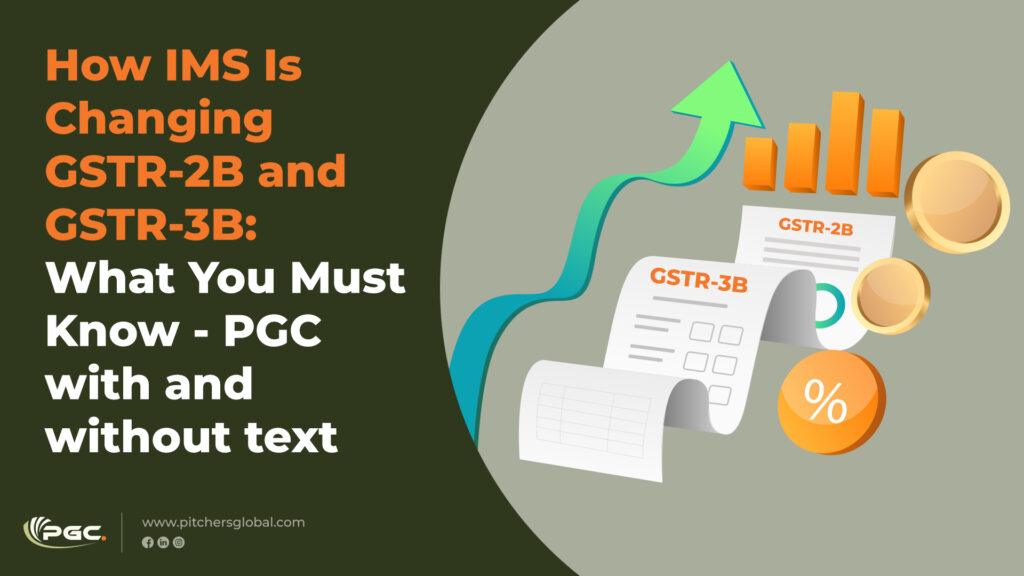Real-time. Rule-based. Remarkably Smarter.
India’s GST system is undergoing a major transformation — and it starts with the Invoice Management System (IMS).
Launched to improve invoice visibility, accuracy, and ITC claims, IMS enables businesses to take real-time actions on supplier invoices. You can now accept, reject, or mark invoices as pending before they hit your GSTR-2B — giving you tighter control, cleaner returns, and fewer mismatches in GSTR-3B.
But with these improvements come new responsibilities.
Here’s a breakdown of what’s changing with GSTR-2B and 3B in the IMS era — and what your business needs to do to stay compliant and optimized.

What Is IMS and Why It Matters
IMS is a tool that lets you view invoices uploaded by your vendors in near real-time. You’re no longer passively waiting for auto-populated data — you can now take action before it’s frozen into your returns.
These actions — Accept / Reject / Pending — directly influence your GSTR-2B and indirectly impact GSTR-3B.
Think of IMS as a pre-filter to avoid invalid ITC claims, reduce reconciliations, and streamline tax positions.
Changes in GSTR-2B with IMS
GSTR-2B is your monthly summary of available ITC — and IMS makes it smarter, dynamic, and more actionable.
1. Visibility Into Rejected ITC
Invoices you mark as “rejected” will now clearly appear in a separate section of your GSTR-2B. While they don’t affect GSTR-3B directly, this gives you transparency into what ITC you’ve consciously disallowed — a huge help in audits and reconciliations.
2. GSTR-2B is a ‘Draft’ Until Actions Are Final
The GSTR-2B generated on the 14th of every month is no longer the final word. If you take any action in IMS after the 14th, you must recompute the form before filing GSTR-3B.
Pro tip from Pitchers Global: Finalize your invoice actions before the 14th to avoid last-minute recalculations and filing delays.
3. Early Actions Shape Your GSTR-2B
Invoices marked as “rejected” or “pending” before the 14th will be excluded from the draft GSTR-2B, helping ensure that only clean and eligible ITC appears in your return.
Example: If a vendor wrongly uploads an invoice under your GSTIN, rejecting it early ensures it won’t show up in your 2B — saving you from mistakenly claiming ineligible ITC.
4. Pending & Rejected Invoices Are Deferred
If marked before the 14th:
- Rejected invoices are excluded from ITC claims.
- Pending invoices are held back until clarified or corrected, and can be claimed in future cycles once validated.
This dynamic system reduces erroneous claims and improves return hygiene.
5. QRMP Alert: One GSTR-2B Per Quarter
For businesses under the QRMP scheme, GSTR-2B is generated only once per quarter (in Month 3). You won’t receive it for Month 1 and 2 — but IMS is still active.
You can still view and act on invoices throughout the quarter. All actions will reflect when the quarterly GSTR-2B is finally generated.
Planning Tip: Track your vendors regularly to avoid piling up mismatches at quarter-end.
Changes in GSTR-3B with IMS
GSTR-3B — your monthly tax summary — is where ITC is claimed, taxes are paid, and mismatches can turn costly.
1. GSTR-2B Follows GSTR-3B Filing
You won’t receive GSTR-2B for the current month until GSTR-3B for the previous month is filed.
For example, your May GSTR-2B will only be generated after filing April’s GSTR-3B — encouraging disciplined return filing and avoiding ITC overlaps.
2. Credit Note Rejections Add to Supplier’s Liability
When a buyer rejects a credit note, it automatically adds to the supplier’s liability in the next GSTR-3B (under Section 3.1a). However, since GSTR-3B doesn’t show this breakdown clearly, suppliers often miss this extra tax impact.
Actionable Insight: Communicate with suppliers on credit note rejections to avoid disputes and unwanted liabilities.
3. Avoid Bulk Credit Notes
Credit notes issued against multiple invoices might create issues if they’re rejected. Since they’re not linked to individual invoices, tracing the root cause becomes tough.
Pitchers Global recommends: Issue credit notes invoice-wise to maintain audit trails and simplify reconciliations.
What IMS Doesn’t Cover: RCM Invoices
IMS does not display invoices under Reverse Charge Mechanism (RCM).
This creates two risks:
- You cannot take any action on RCM invoices via IMS.
- Vendors might misclassify forward charge invoices as RCM, leading you to pay tax under RCM erroneously.
This issue is especially common in industries like logistics, where vendors may not fully understand RCM applicability.
Stay alert: Double-check invoice categories to prevent double taxation and ITC loss.
Key Takeaways for Businesses
- Actions in IMS now define your returns: Accept / Reject / Pending status directly shapes GSTR-2B, and indirectly GSTR-3B.
- GSTR-2B is provisional until the 14th — post that, actions require re-computation.
- ITC accuracy is now in your hands: Rejected/pending invoices won’t appear in 2B.
- File GSTR-3B on time to trigger the next GSTR-2B cycle.
- Credit note rejections = supplier tax liability — communicate clearly to avoid penalties.
- IMS does not show RCM invoices — monitor classification errors manually.
- QRMP filers get only one GSTR-2B per quarter — plan ahead for ITC and working capital.
Need Help Navigating IMS and Return Compliance?
At Pitchers Global, we work with startups, transporters, trading houses, and growth-stage businesses to ensure clean, error-free GST filings — especially under the new IMS-integrated regime.
Whether it’s building a real-time invoice action system or helping reconcile ITC across months, we offer:
- GST advisory with tech-backed workflows
- GSTR-2B/3B filing automation
- RCM review and vendor classification audits
- Industry-specific credit note and return strategies
